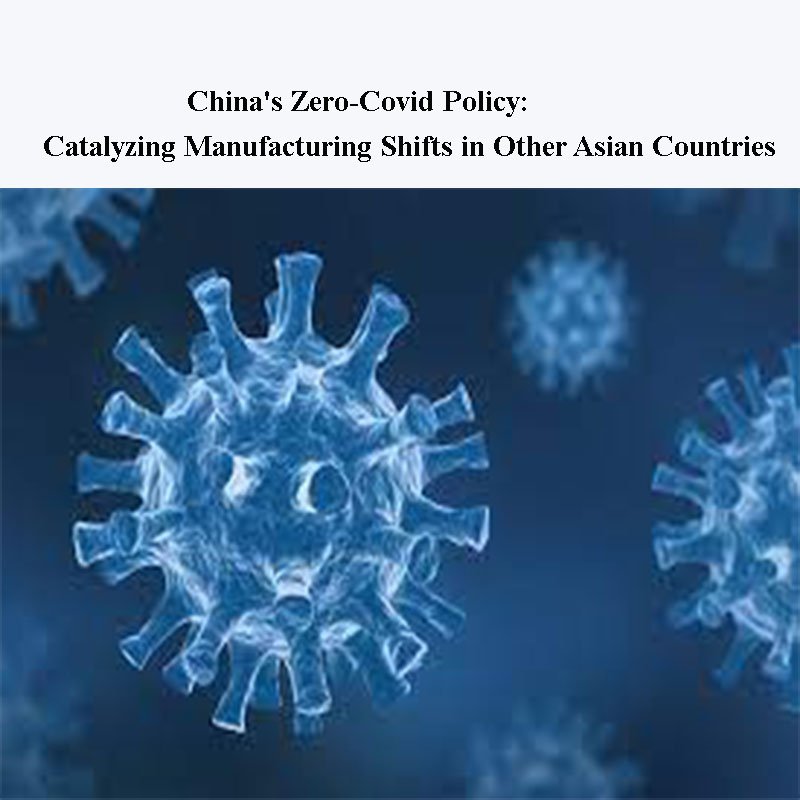Key takeaways
1. The spread of COVID-19 within China’s borders was successfully stopped by the country’s Zero-Covid policy, which is marked by stringent control measures and an emphasis on public health.
2. As a result of this confinement and interruptions in global supply chains, multinational corporations are diversifying their production bases and looking into alternate places in other Asian nations.
3. Asian nations with competitive labor prices, hospitable business climates, and strong infrastructure have made them desirable locations for manufacturing, including Vietnam, Thailand, and Indonesia.
4. These rising economies have experienced tremendous industrial expansion and an infusion of foreign direct investment as a result of the manufacturing changes.
5. The regional industrial landscape has been drastically altered by China’s Zero-Covid policy. landscape, presenting both opportunities and challenges for neighboring Asian countries as they navigate the evolving global manufacturing dynamics.
6. The article highlights the importance of adaptability and flexibility for multinational companies in response to disruptions and changing market conditions.
China’s zero-Covid policy, implemented in response to the COVID-19 pandemic, has had far-reaching implications for the country’s manufacturing sector. This policy, aimed at eradicating the virus within China’s borders, resulted in extensive lockdowns and factory closures, significantly disrupting production. Consequently, many companies have reevaluated their reliance on China as a manufacturing hub and have begun exploring alternative options in other Asian countries. This article delves into the key factors driving this manufacturing shift, including supply chain disruptions, rising labor costs, and concerns about political and economic stability. It also examines the export data and explores the long-term implications of this trend.

Supply Chain Disruptions and Increased Demand:
The pandemic-induced lockdowns and factory closures in China severely disrupted global supply chains. Companies across various sectors faced delays in production and delivery of goods, prompting them to seek alternative sources of supply. Consequently, manufacturing demand in other Asian countries, including Vietnam, India, and Bangladesh, experienced a significant upswing.
According to a report by the Nikkei Asian Review, Vietnam witnessed a 20.8% increase in textile and garment exports in 2020, making it the only country among the top 10 textile and garment exporters to achieve growth during the pandemic. Similarly, India’s exports of textiles and clothing surged by 18.5% in the same period. These statistics indicate a clear shift of manufacturing activity away from China and towards other Asian countries.
Rising Labor Costs:

Another driving force behind the manufacturing shift is the substantial increase in labor costs in China. Over the past few years, wages in the country have been steadily rising, diminishing China’s cost-effectiveness as a manufacturing hub. Consequently, companies have begun exploring alternative destinations with lower labor costs, such as Vietnam and Bangladesh.
According to the Bangladesh Garment Manufacturers and Exporters Association, Bangladesh’s ready-made garment exports increased by 6.4% in 2020. This growth showcases the country’s potential as an emerging manufacturing hub and its ability to attract investment due to its competitive labor costs.
Political and Economic Stability Concerns:
Mounting concerns about political and economic stability in China, particularly amidst the US-China trade tensions, have further fueled the manufacturing shift. Companies now seek to diversify their manufacturing operations to minimize the risk of disruption. Leading technology giants like Apple and Samsung have reportedly expressed intentions to shift some of their production away from China to countries like Vietnam and India.
The Shift in Export Data:
The manufacturing shift away from China is evident in the country’s export data. According to the General Administration of Customs, China experienced a 2.1% decline in exports in 2020, marking the first decrease since 2009. This decline can be attributed to the supply chain disruptions caused by the pandemic and the subsequent relocation of manufacturing to other countries.
Long-term Implications and China’s Dominance:
While the long-term effects of the pandemic on the manufacturing sector are still uncertain, it is evident that the manufacturing shift away from China has been accelerated by the COVID-19 pandemic. However, it is essential to note that the shift is not a complete exodus, as China continues to hold its position as the world’s leading manufacturing hub. The country possesses key advantages such as a vast and skilled workforce, advanced infrastructure and logistics, and a well-developed supply chain.
China’s zero-Covid policy, implemented to combat the COVID-19 pandemic, has had a profound impact on the country’s manufacturing sector. The disruption of supply chains, rising labor costs, and concerns about political and economic stability have all contributed to the acceleration of the manufacturing shift away from China. Other Asian countries, such as Vietnam, India, and Bangladesh, have
Conclusion
In conclusion, other Asian nations’ industrial changes have been greatly accelerated by China’s Zero-Covid policy. Due to its strict control measures and emphasis on public health, China was able to effectively stop the COVID-19 virus from spreading within its borders. Due to this success and disruptions in global supply chains, international corporations are increasingly expanding their production bases and looking for new locations in Asian neighbors. Countries like Vietnam, Thailand, and Indonesia have become popular travel destinations because they have affordable labor, good business climates, and strong infrastructure. These nations are therefore benefiting from a surge in foreign direct investment and rapid industrial expansion. In addition to changing the manufacturing environment in the area, China’s Zero-Covid policy has also brought new possibilities and challenges for these emerging economies as they strive to capitalize on this shifting global manufacturing dynamic.
FAQ
What is the dynamic zero policy in China?
The goal of China’s dynamic zero-COVID policy is to contain and prevent COVID-19 outbreaks at the lowest possible social cost. The salient points are as follows:
1. Zero-Tolerance Approach: China has implemented a zero-tolerance policy for COVID-19 outbreaks since the start of the epidemic. This implies that in order to stop the spread of any new cases, authorities react to them right away.
2. Resource-Intensive Measures: Quarantining, mass testing, and targeted lockdowns are all part of the dynamic zero-COVID strategy. These resource-intensive methods have contributed to the virus’s containment and have kept the death toll remarkably low when compared to other nations2.
3. Challenges Variants have provided challenges: While the method has worked, more recent and transmissible variations—like Omicron—have caused problems. In certain regions, a number of lockdowns have incited ire and frustration.
4. Balancing Act: Minimizing social and economic disturbance while containing breakouts is a nearly difficult undertaking for local leaders. Experts in health concur that, given China’s lack of herd immunity and less effective local vaccinations, opening up today will kill millions of people1.
5. The Importance of immunization: Current policy modifications prioritize raising immunization rates among the senior population. Although recommended, vaccinations are not required, and overcoming vaccine reluctance continues to be difficult1.
6. Tragedies and Commitment: Zero-COVID policies have been connected to tragedies, such as fatalities brought on the unavailability or delay in medical care. In spite of this, China is dedicated to to the policy, as emphasized by President Xi Jinping¹.
In summary, China’s dynamic zero-COVID policy aims to swiftly control outbreaks while maintaining societal functioning and economic development³⁴⁵.
How has COVID-19 affected Chinese exports?
Modifications to Export Trends:
– In May 2020, China shipped more face masks than any other product. In addition, China’s exports of “not elsewhere classified made up textiles” were over $14 billion greater than its typical exports of items like smartphones and portable computers2.
The outbreak changed consumer demand and disrupted the supply chain, which affected the sorts of goods China exported.
2. Healing and Sturdiness:
– As a result of COVID-19, China’s exports dropped sharply in February 2020; however, they quickly recovered and by March, they were back to normal.
In contrast, because of their slower rates of recovery, exports from the US and Germany decreased in April 20202.
3. Brazil’s Agricultural Exports:
– Brazil’s exports of agricultural products rose throughout the outbreak. dramatically. Exports of frozen meat and soybeans increased significantly.
– Soybean monthly exports grew by more than $1 billion year-on-year in April 2020¹.
4. Current Patterns:
– As of September 2021, imports increased by 13.2% and exports increased by 9.9%. In contrast to other major economies currently dealing with the effects of the epidemic, this trade performance is strong1.
– However, as a result of Beijing’s strict COVID-19 regulations, China’s export growth dropped precipitously in April 2022 to 3.9%, the lowest level since June 20202.
5. Total Effect:
– The epidemic affected both demand and production by upsetting international supply systems.
– Annual growth estimates for 2020 may have been impacted by a potential 33.1 billion US dollar decline in China’s total commodity exports.
In conclusion, COVID-19 had a major impact on China’s export trends, rates of economic recovery, and some industries like agriculture. China’s trade performance exhibited resilience in the face of adversity when compared to other economies¹²³⁴.
How was China affected by the COVID-19 pandemic?
China was significantly impacted by the COVID-19 epidemic in terms of both public health and socioeconomic repercussions. The following are some salient points:
Effect on Health:
First Outbreak: In late 2019, Wuhan, China, was the epicenter of the epidemic. Strict lockdowns, overcrowded hospitals, a high rate of illnesses, and fatalities were all present in the city.
China made significant efforts to limit the virus, using quarantine, contact tracking, and mass testing. These initiatives reduced the number of fatalities and helped stop the spread.
China initiated a widespread immunization program with the goal of immunizing its sizable populace. China created several vaccines, including Sinovac and Sinopharm, which were widely utilized.
Economic Repercussions:
Disruptions to the Supply Chain: Lockdowns and personnel reductions caused problems for China’s industrial industry. It had an effect on global supply networks, which affected exports.
Recovery and Resilience: Despite initial setbacks, China’s economy rebounded faster than most other countries. It returned to growth by mid-2020.
Digital Transformation: The pandemic accelerated China’s digital transformation, with increased reliance on e-commerce, online services, and remote work.
Social Impact:
Travel Restrictions: International and domestic travel restrictions affected tourism, airlines, and hospitality industries.
Education and Work: Schools and universities shifted to online learning, and many employees worked remotely.
Mental Health: The pandemic’s psychological impact led to increased awareness of mental health issues.
Global Relations:
Blame Game: China faced criticism for its initial handling of the outbreak. Accusations of lack of transparency and delayed reporting strained international relations.
Vaccine Diplomacy: China engaged in “vaccine diplomacy,” providing vaccines to other countries as part of its soft power strategy.
Scientific Advances:
China played a crucial role in COVID-19 research, including genome sequencing, vaccine development, and clinical trials.
In summary, China experienced both challenges and successes during the pandemic, demonstrating resilience in its response and recovery efforts .
What is China’s 2049 plan?
China’s 2049 plan is a long-term strategic vision outlined by the Chinese government. Let’s delve into the details:
1. Objective:
– By 2049, China aims to achieve “the great rejuvenation of the Chinese nation.” This ambitious goal encompasses economic, diplomatic, and military aspects.
– The plan seeks to transform China into a modern socialist country that is prosperous, strong, democratic, culturally advanced, and harmonious.
2. Key Elements:
– Economic Development: The plan focuses on building a moderately prosperous society by addressing poverty and promoting economic growth.
– Military-Civil Fusion (MCF): China’s strategy involves integrating science, technology, and innovation to advance both economic and military development. The goal is to develop the People’s Liberation Army (PLA) into a “world-class military” by 2049².
– Indigenous Innovation: China aims to enhance its innovation capability, narrow technological gaps with developed nations, and become a world science and technology power by the middle of the 21st century.
3. Challenges and Implications:
– The 2049 plan has significant implications for the global order. It involves periods of cooperation and later confrontation with major trading partners, particularly the US and other democratic nations.
– The world must address China’s actions in the economic, diplomatic, and military spheres to safeguard their interests and prevent potential losses.
In summary, China’s 2049 plan represents a comprehensive vision for the nation’s future, encompassing economic prosperity, military strength, and global influence⁴. The world faces the challenge of balancing cooperation and countering China’s actions to maintain stability and protect its interests.
Hope this article was helpful for more checkout our previous blog post by clicking here


